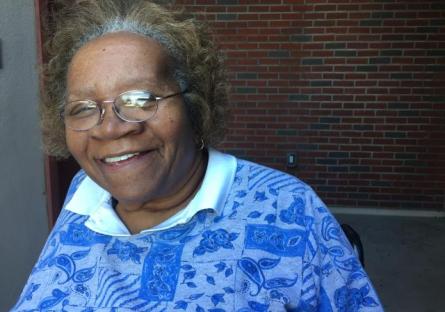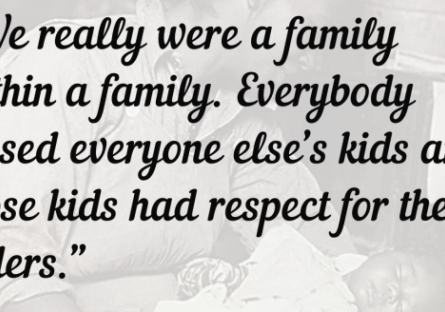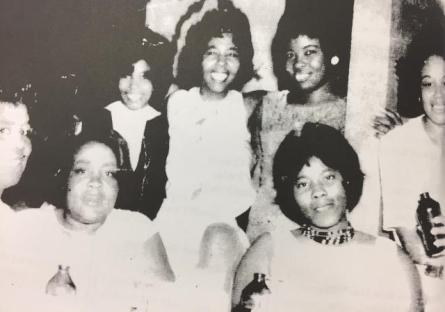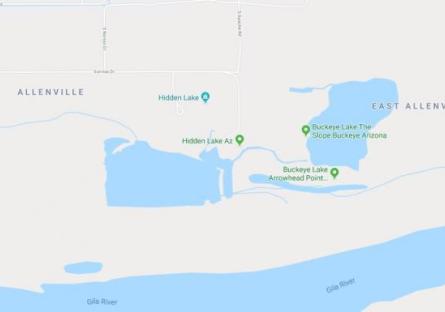



If you search “Buckeye map” on Google, you’ll see a place just east of Miller Road and north of the Gila River called Allenville. But if you drive there, all you’ll see are weeds, bushes, and salt cedar trees. Unless you look really close, and then you may see a brick frame, the only reminder that an entire community once called the area home.
In honor of Black History Month, we’re looking back at Allenville, an all-Black community that lived in harmony from 1944 until 1978 when a devastating flood forced everyone to abandon the one-square-mile town for good. It wasn’t the first flood to wreak havoc on the tightly knit community; Allenville was, after all, situated right in the middle of a floodplain. Flooding was so commonplace that the residents would simply leave and wait for the water to recede before returning home to repair and/or rebuild.
“The water line inside the house would be knee-high and the mud would be ankle-deep,” said Jo Ann (nee Anderson) Shoemaker, who grew up in Allenville and later penned the book “A Family within a Family: The History of Allenville, Arizona.”
The Anderson family, like the rest of their neighbors, would then begin the arduous task of making their home livable once again.
“We’d keep what we could and throw out what we couldn’t,” Shoemaker said. “Luckily, the water never reached our mattresses, but the smell lasted a long time.”
Allenville was established in 1944 when Fred Norton, a Phoenix Realtor, bought a parcel of land from the county, subdivided it, and sold it to Blacks beginning with John Allen, the town’s namesake. At the time, Blacks were not allowed to live in Buckeye. Before the 1968 Fair Housing Act, racist deeds and housing covenants existed that explicitly barred them from living in certain areas. But Black people were flocking to the Valley from all over the country to work in the cotton industry, which was booming. Many were living in tents or metal shacks in camps right in the fields they were working. Allenville was their chance to have homes of their own and put down some roots.
While some accounts list the population of Allenville as 400 at its peak, others say it was closer to 800. Either way, the town was as close-knit as they come.
“You knew everybody,” Shoemaker said. “Like the title of my book, we really were a family within a family. Everybody raised everyone else’s kids and those kids had respect for their elders.”
Allenville was also filled with an unrivaled entrepreneurial spirit. It didn’t take long for several backroom cafes, pool halls, and a bar to open.
“Adults could often be found over at Big Earl’s Cafe/Bar,” Shoemaker writes. “Teenagers would hang out at Mr. Jones’ and for a time at Ms. Cora’s or Vera’s where they would eat and dance. The penny candy, ice cream, and pop at Ms. Sugar’s or Ms. Aimee’s attracted the younger children.”
The town even had an adult education facility and daycare center, which was used not just by Allenville residents, but also by Buckeye families.
“That was my first summer job,” said Rachel Lee, who like Shoemaker, grew up in Allenville.
One of the few amenities the town lacked was adequate drinking water.
“It was terrible, salty, you just couldn’t drink it,” Shoemaker said.
Instead, water was trucked in and residents would collect it in whatever containers they could get their hands on. According to a 1969 Arizona Republic news article, they used gallon peach tins, old tomato containers, shortening jars, and even paint tins rubbed free of latex.
Both Shoemaker and Lee attended Buckeye Elementary School in the 1960s, several years after the Supreme Court ruled unanimously in Brown v. Board of Education that “separate but equal” was unconstitutional under the Equal Protection Clause of the Fourteenth Amendment. But prior generations of Black children, including Lee’s father, Arthur Wilburn, were bused to Palo Verde Colored School.
“Mr. Arthur Wilburn Jr. attended the Palo Verde Colored School from 1946 to 1954,” Shoemaker writes. “He describes the school as having two buildings. There was one classroom building. It had two rooms, one for grades 1 through 4 and one for grades 5 through 8. Students usually had used textbooks. Many of the desks, chairs and other furnishings were State surplus.”
Still, neither woman recalls experiencing any outward racism while living in Allenville.
“I believe racism existed, I personally never experienced any racism,” Lee said. “The people I went to school with, even today, we still have a connection and relationship through social media, so I never experienced those types of prejudices but I know they existed. Buckeye has been more farm vs. nonfarm. Those are the types of prejudices I saw, not necessarily racial.”
Allenville, as small as it was, was never lacking for spiritual guidance. At one time, the town boasted three churches: Mt. Pleasant Missionary Baptist, the oldest of the three, Mt. Zion Holy Spiritual Church, and a Methodist church.
“One of my fondest memories was attending church,” Shoemaker said. “After church, the pastor and I would just walk up and down from one end of Allenville to the other just talking about nothing in particular.”
By the time the town’s final flood hit in 1978, Shoemaker had already moved with her family to the Valencia community, but Lee, who was a senior in high school, remembers the temporary accommodations provided by the federal government.
“We lived in trailers for a bit,” she said. “They put us all in trailers on Beloat Road.”
Lee’s family moved to downtown Buckeye the following year, but many of Allenville’s residents would call the temporary lodgings home for the next three years.
Following the 1978 flood, then-Gov. Bruce Babbit declared Allenville a disaster area and the Army Corps of Engineers was brought in to find a solution to the flooding problem. The Corps came up with several possibilities, including channeling the river, building a dam or levy, or relocating the entire town. In 1981, the town was relocated just off Palo Verde Road, ¼ mile south of Interstate 10, about 8 miles north of Allenville.
In a land swap, homeowners were given fair market value for their property and renters were given the option to purchase their trailers for a “nominal fee” and relocate them to Hopeville. The plan called for 20 houses, facilities for 20 mobile homes, a community center and park, and land for two churches, a lodge, and a commercial area.
Today, Hopeville has a few homes, a church, but no community center. That burned to the ground in 2016. The lodge and commercial center never came to fruition, and a 2016 monsoon storm destroyed many of the trailers and damaged several homes, some of which still bear the scars, only slightly hidden under blue tarps. Overall though, Lee thinks the relocation was a good thing for the residents of Allenville.
“Personally, I thought it was a good thing,” she said. “The conditions in Allenville we tolerated, we were used to, we made it work, but relocating I still think was a good thing. A lot of people’s living conditions got better. The water was totally the polar opposite. It was like getting water out of a reverse osmosis system. It was drinkable, it was great, so I never saw it as a negative. It was good on a lot of fronts.”
The downside, Lee said, is that the essence of Allenville was lost when the entire community did not choose to relocate to Hopeville.
“We lost that sense of community when everyone didn’t relocate,” she said. “That’s the downside. That phrase ‘It takes a village,’ that’s what was lost.”